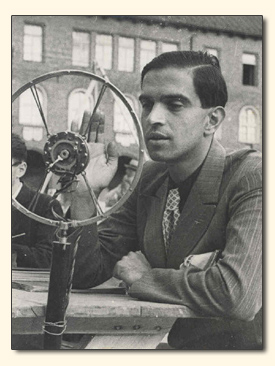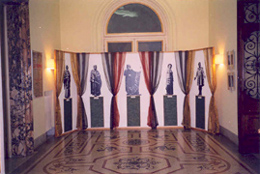

GUSZTÁV OLÁH – WIZARD OF THE STAGE
Centennial exhibitions
Ernst Museum, Budapest, October 17 – November 11, 2001
Herman Ottó Museum, Miskolc, June 14 – 30, 2002
Hungarian Academy, Rome, December 2, 2002 – January 15, 2003
 Gusztáv
Oláh (1901–1956) was an outstanding set and costume designer and a significant
artist of theatre life in Hungary. He spent his life being involved in the magic
of the stage from his early childhood.
Gusztáv
Oláh (1901–1956) was an outstanding set and costume designer and a significant
artist of theatre life in Hungary. He spent his life being involved in the magic
of the stage from his early childhood.
He studied at the Academy of Music and the University of Technology and also
learned stage directing under the guidance of Sándor Hevesi and László Márkus.
He became set designer attendant of the Budapest Opera House at the age of twenty
in 1921, his master was Jenő Kéméndy. During his career he directed various
fields of stage work beside his activity as set and costume designer at various
theatres (Nemzeti Színház /National Theatre/, Városi Színház /City Theatre,
Budapest/); from 1927 he was appointed scenic supervisor of the state theatres
and from 1936 chief stage director of the Opera House until his death.
He also won fame abroad from 1936 as warmly welcome guest designer and stage
director at famous opera houses in Verona, Florence, Milan, Stockholm and Munich.
He worked continuously for Hungarian open-air theatres as well.
He taught set designing at the College of Applied Arts and the art of moving
on stage to singers at the Academy of Music. He won the Kossuth Prize twice,
in 1951 and 1954. In 1952 he received the Eminent Artist Prize.
His magical designs conveyed a brilliant talent´s fantasy and immense practical
knowledge of an outstanding personality who served theatre arts on a high standard
both in musical composition and in stage realization in the period of a golden
age of the Budapest Opera House.
He was a professional who guaranteed the high quality of performances with his
devotion and his demands towards his colleagues.
He worked together with eminent composers and theatre men in the course of his
manysided activity like Sergio Failoni, Kálmán Nádasdy, later conductor János
Ferencsik and the guest conductor Otto Klemperer who stayed in Budapest for
several seasons. From among Oláh’s excellent designer colleagues we have
to mention Zoltán Fülöp and Tivadar Márk, and among his talented students Árpád
Csányi, Róbert Wegenast and Gábor Forray who later also became noted set designers.
The centennial exhibition of his birth was opened at Ernst Museum in Budapest in 2001. The magnificent selection of his life-work offered a spectacular overview including set and costume designs, sketch-books, drawings, photographs, and also studies and articles by him and on his art. The public could also meet these masterpieces of scenography at Herman Ottó Museum in Miskolc during the International Opera Festival entitled ’Bartók + Puccini’ in 2002. From the end of the same year the exhibition was also presented at the Hungarian Academy in Rome.
 |
 |
 |
Ernst Museum, October 2001 |
Miskolc, June 2002 |
Rome, December 2002 |
Curator: Hedvig
Belitska-Scholtz
Curator's assistants: Zita Burda, Olga Somorjai, Nóra Wellmann
Designer: Gábor Bíró